
Busan, formerly known as Pusan and now officially Busan Metropolitan City, is South Korea's second most-populous city after Seoul, with a population of over 3.5 million inhabitants. It is the economic, cultural and educational center of southeastern Korea, with its port—Korea's busiest and the 9th-busiest in the world—only about 120 miles (190 km) from the Japanese islands of Kyushu and Honshu. The surrounding "Southeast Economic Zone" is now South Korea's largest industrial area.
Yeungnam University is a private research university, located in Gyeongsan, North Gyeongsang, South Korea. The university's predecessors, Taegu College and Chunggu College, were founded in Daegu in 1947 and 1950 respectively. In 1967, the two colleges merged by President Park Chung-hee to form the degree-granting Yeungnam University. In 1972, the university's new main campus opened in Gyeongsan east of Daegu. The university includes colleges of Law and Medicine and a teaching hospital.

Cheonan, also spelled Ch'ŏnan, is a city in South Chungcheong, South Korea.
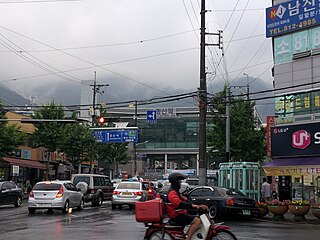
Gyeongsan is a city in North Gyeongsang Province, South Korea. Its western border abuts the metropolitan city of Daegu, and much of Gyeongsan lies within the Daegu metropolitan area.

The Daegu subway fire occurred on February 18, 2003, when an arsonist set fire to a train which killed 192 people and injured 151 others at the Jungangno Station of the Daegu Metropolitan Subway in Daegu, South Korea. The fire had spread across two trains within minutes.
Throughout and before recorded history, Daegu has served as a nexus of transportation, lying as it does at the junction of the Geumho and Nakdong rivers. During the Joseon Dynasty, the city was the administrative, economic and cultural centre of the entire Gyeongsang region, a role largely taken over now by Busan in South Gyeongsang.
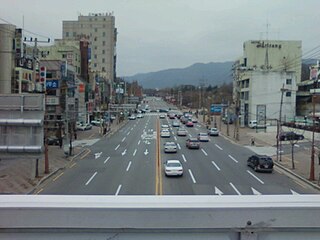
Duryu is a dong in Dalseo-gu, western Daegu, South Korea. It is the site of Duryu Park and Woobang Tower Land, a popular Daegu amusement park. Although legally a single dong, Duryu-dong is divided into three administrative dong: Duryu-1[il]-, -2[i]-, and -3[sam]-dong. Together, the three administrative dong cover 2.44 km². They were home to 34,280 people as of October 31, 2005.

Yeouido is a large island on the Han River in Seoul, South Korea. It is Seoul's main finance and investment banking district. Its 8.4 square kilometers are home to some 30,988 people. The island is located in the Yeongdeungpo-gu district of Seoul, and largely corresponds to the precinct of Yeouido-dong. The island contains the National Assembly Building, where the National Assembly of South Korea meets, Korea Financial Investment Association, the large Yoido Full Gospel Church, the 63 Building, and the headquarters of LG, Korean Broadcasting System, and the Korea Exchange Center. Due mainly to its importance as a financial district and its central location, Yeouido is home to some of Seoul and South Korea's tallest skyscrapers, including International Finance Center Seoul, the Federation of Korea Industries Tower, as well as the iconic 63 Building.
Daegu International School is an international school in Dong-gu, Daegu, South Korea. It was established on August 13, 2010 and serves Kindergarten through grade 12.
Gyo-dong is a dong or neighborhood in the metropolitan city of Daegu, South Korea. It is one of legal dong under its administrative dong Seongnae 1-dong's jurisdiction. The name, Gyo-dong originates from the fact that the area has had a hyanggyo, government-managed Confucian academies during the Joseon Dynasty. It belonged to Dongsang-myeon, Daegu-bu during the Joseon Dynasty
Shinsegae is a South Korean department store franchise, along with several other businesses, headquartered in Seoul, South Korea. The name Shinsegae literally means "New World" in Korean. Its flagship store in Centum City, Busan, is the world's largest department store, surpassing Macy's flagship Herald Square in New York City in 2009.

Yulha Station is a station of Daegu Subway Line 1 in Yulha-dong, Dong District, Daegu, South Korea. Two exits was established in 2010. There is a Beomanno road to south. Apartments were built by new city development to the neighborhood.
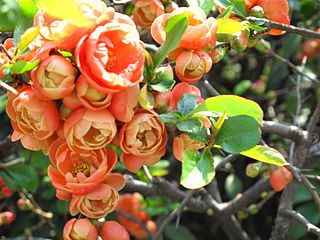
Duryu Park, founded in 1965, is a park located in Duryu-dong, Daegu Dalseo-gu, South Korea.
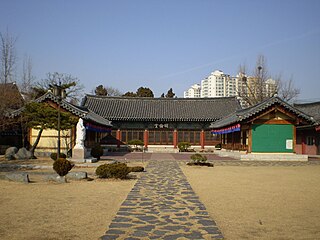
The Daegu Hyanggyo was founded in 1398 during the reign Joseon Dynasty King Taejo. During the Second Japanese Invasion in 1592 it was completely burned down. In 1599 the Daegu Hyanggyo was rebuilt near Dalseong Park but was relocated to the original 1398 site of Dalseong Park in 1605 and then back to the Gyodong area again. 1932 saw the hyanggyo again relocated to its present location in Namsandong, just south of downtown Daegu. In 1973 Hyanggyo at Daegu underwent a full restoration.
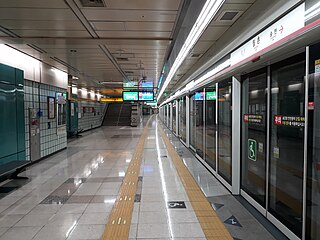
Wolchon Station is a station of a city railroad of Daegu Metro Line 1 in Dalseo District, Daegu, South Korea. There are 8 exits:

Daegu Grand Park Station is a station of the Daegu Metro Line 2 in Yeonho-dong, Suseong District, Daegu, South Korea. Daegu Grand Park is not yet opened.
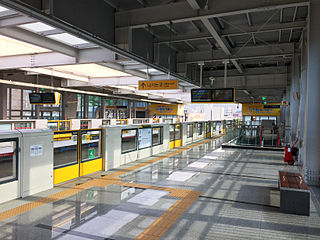
Children's Hall Station is a station of the Daegu Metro Line 3 in Hwanggeum-dong, Suseong District, Daegu, South Korea.
















